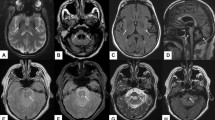Abstract
Purpose
Cerebellar tubers have been recognized as a feature of tuberous sclerosis complex (TSC), but the evolution of cerebellar tubers with brain maturation remains unclear. The aim of this study was to assess the evolution of MRI characteristics of cerebellar tubers in children with TSC longitudinally.
Methods
The MRI features of cerebellar tubers including number, location, shape, enhancement, presence of hemorrhage, calcifications, retraction, and the longitudinal changes of these features were assessed in children with TSC.
Results
Cerebellar tubers were seen in 69/193 (35.8 %) cases. Cerebellar tubers were wedge shaped, nodular, or demonstrated folia distortion; 33/101 (32.7 %) cerebellar tubers showed enhancement, 29/101 (28.7 %) showed calcification, and 75/101 (74.3 %) had retraction abnormality. No lesion showed hemorrhage. One hundred fifty-two of our patients had more than one MRI examinations and were followed for a mean of 5.3 years from the time of their first MRI till their last study. Of those with follow-up MRI, 53 patients had cerebellar tubers; 15/53 (28.3 %) patients and 20/101 (19.8 %) of the cerebellar tubers demonstrated an increase in size, enhancement, or calcification longitudinally. The majority of the increase in size, enhancement, or calcification occurred in the first 8 years of life. None of the cerebellar tubers showed a reduction in size or enhancement. There was no new cerebellar tuber.
Conclusion
We have found an increase in size, enhancement, and calcification of cerebellar tubers which occurred mainly in the first 8 years of life. Further study that correlates the genetics and clinical manifestation with more advanced imaging of the cerebellar tubers may help us understand the underlying neurobiology of the changes in cerebellar tubers.



Similar content being viewed by others
References
Hyman MH, Whittemore VH (2000) National Institutes of Health consensus conference: tuberous sclerosis complex. Arch Neurol 57(5):662–665
Luat AF, Makki M, Chugani HT (2007) Neuroimaging in tuberous sclerosis complex. Curr Opin Neurol 20(2):142–150. doi:10.1097/WCO.0b013e3280895d93
Asano E, Chugani DC, Muzik O, Behen M, Janisse J, Rothermel R, Mangner TJ, Chakraborty PK, Chugani HT (2001) Autism in tuberous sclerosis complex is related to both cortical and subcortical dysfunction. Neurology 57(7):1269–1277
Menor F, Marti-Bonmati L, Mulas F, Poyatos C, Cortina H (1992) Neuroimaging in tuberous sclerosis: a clinicoradiological evaluation in pediatric patients. Pediatr Radiol 22(7):485–489
Ertan G, Arulrajah S, Tekes A, Jordan L, Huisman TA (2010) Cerebellar abnormality in children and young adults with tuberous sclerosis complex: MR and diffusion weighted imaging findings. J neuroradiol J de neuroradiol 37(4):231–238. doi:10.1016/j.neurad.2009.12.006
Eluvathingal TJ, Behen ME, Chugani HT, Janisse J, Bernardi B, Chakraborty P, Juhasz C, Muzik O, Chugani DC (2006) Cerebellar lesions in tuberous sclerosis complex: neurobehavioral and neuroimaging correlates. J Child Neurol 21(10):846–851
Jay V, Edwards V, Musharbash A, Rutka JT (1998) Cerebellar pathology in tuberous sclerosis. Ultrastruct Pathol 22(4):331–339
Marti-Bonmati L, Menor F, Dosda R (2000) Tuberous sclerosis: differences between cerebral and cerebellar cortical tubers in a pediatric population. AJNR Am J Neuroradiol 21(3):557–560
Sener RN (1998) Cerebellar involvement in tuberous sclerosis. Comput med imaging graph : off J Comput Medical Imaging Soc 22(1):63–65
Roach ES, Sparagana SP (2004) Diagnosis of tuberous sclerosis complex. J Child Neurol 19(9):643–649
Braffman BH, Bilaniuk LT, Naidich TP, Altman NR, Post MJ, Quencer RM, Zimmerman RA, Brody BA (1992) MR imaging of tuberous sclerosis: pathogenesis of this phakomatosis, use of gadopentetate dimeglumine, and literature review. Radiology 183(1):227–238
Vaughn J, Hagiwara M, Katz J, Roth J, Devinsky O, Weiner H, Milla S (2013) MRI characterization and longitudinal study of focal cerebellar lesions in a young tuberous sclerosis cohort. AJNR Am J Neuroradiol 34(3):655–659. doi:10.3174/ajnr.A3260
Castillo M, Whaley RA, Point SW, Black JA (1992) Gyriform enhancement in tuberous sclerosis simulating infarction. Radiology 185(2):613–614
Girard N, Zimmerman RA, Schnur RE, Haselgrove J, Christensen K (1997) Magnetization transfer in the investigation of patients with tuberous sclerosis. Neuroradiology 39(7):523–528
Chu-Shore CJ, Major P, Montenegro M, Thiele E (2009) Cyst-like tubers are associated with TSC2 and epilepsy in tuberous sclerosis complex. Neurology 72(13):1165–1169. doi:10.1212/01.wnl.0000345365.92821.86
Courchesne E, Chisum HJ, Townsend J, Cowles A, Covington J, Egaas B, Harwood M, Hinds S, Press GA (2000) Normal brain development and aging: quantitative analysis at in vivo MR imaging in healthy volunteers. Radiology 216(3):672–682. doi:10.1148/radiology.216.3.r00au37672
Conflict of interest
The authors declare that they have no conflict of interest.
Ethical standards
The study has the approval of the institution’s research ethics board, and the research procedures followed were in accordance with the ethical standards of the Helsinki Declaration of 1964 and its later amendments. Due to the retrospective nature of the study, the need for patients’ informed consent was waived.
Author information
Authors and Affiliations
Corresponding author
Rights and permissions
About this article
Cite this article
Daghistani, R., Rutka, J. & Widjaja, E. MRI characteristics of cerebellar tubers and their longitudinal changes in children with tuberous sclerosis complex. Childs Nerv Syst 31, 109–113 (2015). https://doi.org/10.1007/s00381-014-2542-0
Received:
Accepted:
Published:
Issue Date:
DOI: https://doi.org/10.1007/s00381-014-2542-0




